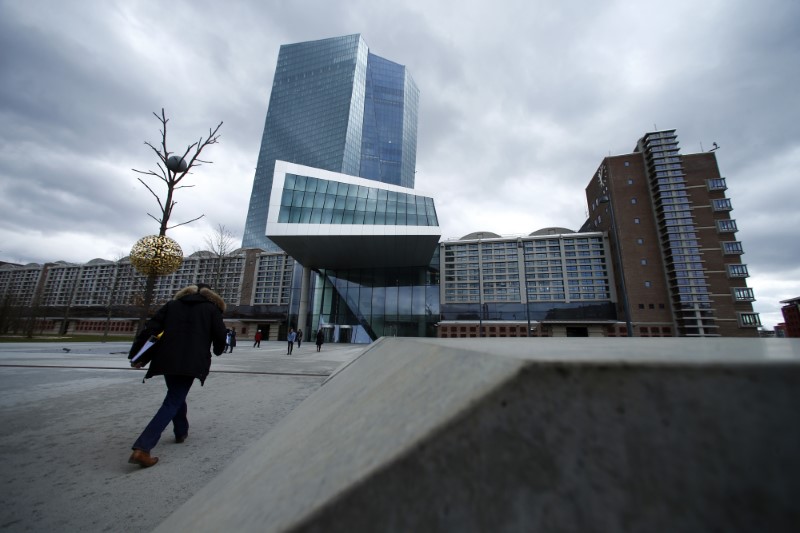 © Reuters. European Central Bank (ECB) headquarters building is seen in Frankfurt
© Reuters. European Central Bank (ECB) headquarters building is seen in FrankfurtBy Balazs Koranyi
WASHINGTON (Reuters) – A recent string of sluggish euro zone data is not signaling a fundamental break in the bloc’s growth path and is not expected to impact the European Central Bank’s plans to normalize policy, three sources with direct knowledge of the bank’s thinking said.
Policymakers still expect bond purchases to end by the end of this year and see the ECB’s first interest rate increase sometime in the second quarter of 2019, the sources told Reuters on the sidelines of the International Monetary Fund and World Bank spring meeting in Washington.
“We have always projected a bit of a slowdown, so I’m not concerned at all,” one of the sources said. “There is also some evidence that one-off factors pulled down growth in the first quarter.”
Having kick-started growth by pushing borrowing costs to rock-bottom levels, ECB policymakers are considering how and when to end their 2.55 trillion euro bond purchase program, taking another step in winding down crisis-era stimulus and reverting to conventional policy tools.
Markets expect the ECB to exit the quantitative easing (QE) program in the fourth quarter after winding down the purchases over several months, and then to raise rates before mid-2019.
“I’m still totally comfortable with those expectations,” a second source said. “The data that have come through are not dramatic. They may have been on the weak side but fit in with a trend of growth in excess of potential.”
“We’ve been growing above potential so it’s natural for growth to slow over time,” he source added.
The ECB declined to comment.
While the euro zone economy has been expanding for 20 straight quarters, output figures, PMI readings and sentiment indicators suggest growth may have slowed to around 0.3 percent or 0.4 percent in the first quarter from 0.6 percent three months earlier.
ECB President Mario Draghi highlighted the bloc’s robust growth on Friday, arguing that the key risks are external while domestic growth drivers are intact.
“Notwithstanding the latest economic indicators, which suggest that the growth cycle may have peaked, the growth momentum is expected to continue,” Draghi said in Washington.
“Downside risks continue to be related primarily to global factors, including rising protectionism,” Draghi said.
“The latter may have already had some negative impact on global sentiment indicators. In this context, preserving free and open trade that is underpinned by multilateral cooperation is crucial to foster a favorable global economic environment,” he added.
The ECB will next meet on April 26. The sources said no substantial policy change is expected at that meeting, with only marginal tweaks in the policy language likely.
More substantial decisions on the future of asset buys will be coming in June and July as the bond purchases are now scheduled to expire by the end of September.
The central bank has long predicted that growth would slow in the coming years, to 2.4 percent this year and then to 1.9 percent next year.
Fusion Media or anyone involved with Fusion Media will not accept any liability for loss or damage as a result of reliance on the information including data, quotes, charts and buy/sell signals contained within this website. Please be fully informed regarding the risks and costs associated with trading the financial markets, it is one of the riskiest investment forms possible.
Source: Investing.com





























